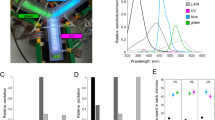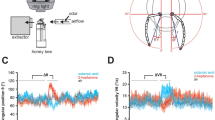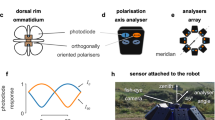Abstract
A solution to the long-standing problem of how honey bees detect polarized light from the sky is presented. The mechanism involves the transformation of polarization information into modulations of perceived brightness while the bee scans the sky by rotating its field of view. Using this technique the bee needs only a very simple strategy to read compass information from the polarization patterns in the sky.
This is a preview of subscription content, access via your institution
Access options
Subscribe to this journal
Receive 51 print issues and online access
$199.00 per year
only $3.90 per issue
Buy this article
- Purchase on Springer Link
- Instant access to full article PDF
Prices may be subject to local taxes which are calculated during checkout
Similar content being viewed by others
References
von Frisch, K. Naturwissenshaften 35, 38–43 (1948).
von Frisch, K. Experientia 5, 142–148 (1949).
von Frisch, K. The Dance Language and Orientation of Bees (Harvard University Press, Cambridge, Massachusetts, 1967).
Laughlin, S. B., Menzel, R. & Snyder, A. W. in Photoreceptor Optics (eds Snyder, A. W., Menzel, R. 237–259 (Springer, Berlin, 1975).
Wehner, R. & Strasser, S. PhysioL Ent. 10, 337–349 (1985).
Helversen, O. & Edrich, W. J. comp. Physiol. 94, 33–47 (1974).
Sommer, E. W. Thesis, Univ. Zürich (1979).
Labhart, T. J. comp. Physiol. 141, 19–30 (1980).
Wehner, R. Himmelsnavigation bei Insekten. Neurophysiologie und Verhalten, Neujahrsbl. Naturforsch. Ges. Zuerich 184 (1982).
Rossel, S., Wehner, R. & Lindauer, M. J. comp. Physiol. 125, 1–12 (1978).
Rossel, S. & Wehner, R. Proc. natn. Acad. Sci. U.S.A. 79, 4451–4455 (1982).
Rossel, S., Wehner, R. J. comp. Physiol. A154, 607–615 (1984).
Wehner, R. & Rossel, S. in Experimental Behavioural Ecology (eds Hoelldobler, B. & Lindauer, M.) 11–53 (Fischer, Stuttgart, 1985).
Waterman, T. H. & Horch, K. W. Science 154, 467–475 (1966).
Kirschfeld, K. Z. Naturforsch. 27b, 578–579 (1972).
Waterman, T. H. in Handbook of Sensory Physiology, Vol. VII/6B (ed. Autrum, H.) 281–469 (Springer, Berlin, 1981).
Dyer, F. C. & Gould, J. L. Science 214, 1041–1042 (1981).
Waterman, T. H., In Photoreception and Vision in Invertebrates (ed. AH, M. A.) 63–114 (Plenum, New York, 1984).
Burghause, F. Zool. Jb. Physiol. 83, 502–525 (1979).
Wunderer, H. & Smola, U. Int. J. Insect Morph. Embryol. 11, 25–38 (1982).
Author information
Authors and Affiliations
Rights and permissions
About this article
Cite this article
Rossel, S., Wehner, R. Polarization vision in bees. Nature 323, 128–131 (1986). https://doi.org/10.1038/323128a0
Received:
Accepted:
Issue Date:
DOI: https://doi.org/10.1038/323128a0
This article is cited by
-
Varieties of visual navigation in insects
Animal Cognition (2023)
-
Magnetic Sensing through the Abdomen of the Honey bee
Scientific Reports (2016)
-
Evidence for the presence of biogenic magnetic particles in the nocturnal migratory brown planthopper, Nilaparvata lugens
Scientific Reports (2016)
-
Steering intermediate courses: desert ants combine information from various navigational routines
Journal of Comparative Physiology A (2016)
-
Path integration, views, search, and matched filters: the contributions of Rüdiger Wehner to the study of orientation and navigation
Journal of Comparative Physiology A (2015)
Comments
By submitting a comment you agree to abide by our Terms and Community Guidelines. If you find something abusive or that does not comply with our terms or guidelines please flag it as inappropriate.



